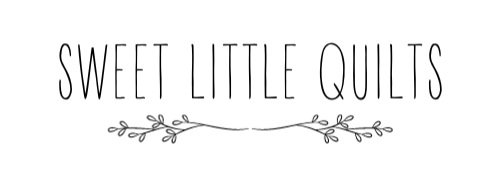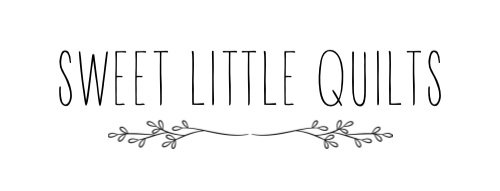Finishing Your Quilt with a Facing - Binding’s Not the Only Game in Town!
Finishing a quilt can be the best feeling after all the steps of choosing fabrics, a pattern, piecing, pressing and quilting. It seems that adding a binding is the only option to finishing your quilt, but I would like to introduce you to facing, my favorite quilt finish.
Like binding, there are many options …
facing strip size
single-fold (like quilt binding) or one layer of fabric
corner options: straight overlap, triangles or bias cut
… but for now I will share a single-fold, straight overlap option because it’s basic, clean and a great start.
To get started, you will need:
Sewing machine and matching or complementary thread
Scissors
Prepared facing strips
Iron, ironing board
Applique or basic white school glue
Binding needle of your choice, matching thread and thimble
You will need to choose the size of your facing strips. I like more width on the back of my quilt, so I chose to begin with 3-1/2” strips, folded and pressed in half, to have a finished facing of 1-3/4”. This is a fairly wide facing, so you will likely want to start with this or a narrower width for your quilt. You will want it large enough to add a nice frame to your quilt back.
For this example, I chose to add the facings to each side by working around the quilt: top, side, bottom, side. You will need to prepare your facing strips in one continuous length, much like you would binding strips. This will allow you to cut the strips as you are attaching them to the quilt. With your long, prepared facing strip in hand and gathered supplies, you are ready to get started.
The photos above (left to right in rows) will provide a visual for the steps below.
To attach the first strip, with your quilt facing up, begin sewing the prepared facing strip to the first side (can be top, side or bottom) 1/2” from the top and stopping/cutting 1/2” from the end. Leave the raw edges as they will be covered. The photo shows the fabric extending beyond the quilt which is how it will look on the next strips that are attached. For the first strip, approximately 1/2” will be open on both ends.
With a hot iron (steam is optional), press the facing strip away from the quilt. The photo shows the back of the quilt.
Return to the sewing machine and top stitch the facing approximately 1/8” from the seam to catch all layers of the quilt and facing. This stitch line will be visible on your finished quilt, so you will likely want to match your thread to your fabric, keep a straight line and I prefer a slightly longer stitch length.
Return to your ironing station and with your hot iron, press the facing to the back of the quilt. This is an important step to finishing a beautiful facing. The seam joining the facing to the quilt should be on the side with the top stitching on the back. Take your time to have the facing straight and completely on the back with none of the facing showing on the front. By pressing at this stage, the facing will not stay completely flat on your backing because there is too much bulk, but will give it memory as you begin gluing it down.
Next, with your glue, run a thin line along the seam (it doesn’t take much), in a workable length. I usually cover the length that will fit on my ironing board.
Next add a thin line of glue along the inside top of the facing (you want it close, but leaving enough room to avoid having to stitch through the dried glue) before adding a wavy line between the two lines of glue you’ve added. This will hold the facing straight and flat until you are ready to stitch it down.
Being careful to fold the facing completely to the backing as in step 4, in small sections, press the glued facing to the backing. There’s no need to rush at this step. Your careful attention now will give you a beautiful finish. Do not hold the iron too long on the fabric, especially if it is light, as the glue can burn. Only hold the iron long enough to seal the glue. Repeat steps 5-7 until you have the entire facing strip securely glued to the backing. You are now ready to hand stitch the facing to the backing with an invisible stitch before adding the facing to the next side. I usually add a few stitched along the raw edges to secure them. They will be covered by the next strips.
Note: If your facing strips are narrower, be sure they will cover the previous raw edge strips when turned to the backing. You want them to be covered, but not inside the 1/4” seam area to avoid having overly bulky seams.
For the next two sides, you will begin stitching the facing strip at the top of the side with the strip extending 1” beyond the quilt and ending/trimming 1/2” from the bottom. Repeat the ironing, topstitching and memory ironing as above, but you will add preparing the corners before you start gluing.
Before beginning steps 5-7, you will need to prepare the corners by folding the corner inside and gluing it in place. You will want the finished corner to match the previous side when ironed down. The last photo shows the corner once it has been pressed, glued and then hand stitched. After the corner is turned in, continue with steps 5-7 to finish the side.
For the best corners, use tiny stitches, as invisibly as possible, close together, to pull the facing fabric to the pressed under quilt top. It will give you a beautiful, square finish.
The final side will follow the steps of the last two sides, but the facing strip will extend 1” beyond the top and bottom to form the last two corners. Follow the remaining steps and you have a finished quilt facing.
I look forward to seeing your quilt facings. I still add bindings to quilts, but there are many times when a quilt facing gives the look I want. Be sure to tag me on Instagram so I can see your work.
I’ll be adding further quilt facing tutorials and have one planned for a baby quilt. I’ve thought about adding a silkier facing fabric as little ones love touching a satiny edge.
I’m so glad you are here. Be sure to subscribe to the newsletter to keep up with new content.















